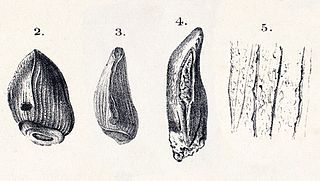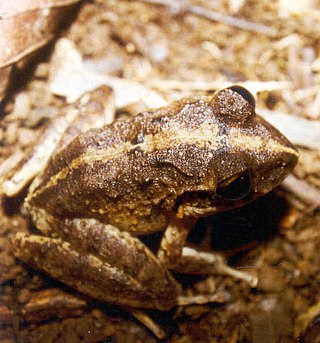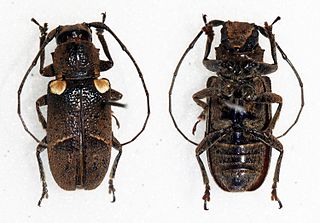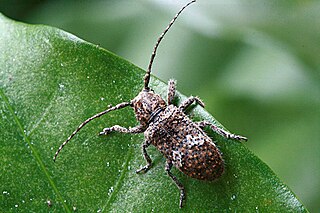
Cardiodon was a herbivorous genus of sauropod dinosaur, based on a tooth from the late Bathonian-age Middle Jurassic Forest Marble Formation of Wiltshire, England. Historically, it is very obscure and usually referred to Cetiosaurus, but recent analyses suggest that it is a distinct genus, and possibly related to Turiasaurus. Cardiodon was the first sauropod genus named.
Bullfrog is a common English language term to refer to large, aggressive frogs, regardless of species.

Craugastor rugulosus is a species of frog in the family Craugastoridae. It is endemic to Mexico. Its natural habitats are subtropical or tropical dry forests, subtropical or tropical moist montane forests, and rivers. It is threatened by habitat loss.

The Chinese edible frog, also known as East Asian bullfrog and Taiwanese frog, is a species of frog in the family Dicroglossidae. It is found in Cambodia, China, Hong Kong, Laos, Macau, Malaysia, Myanmar, the Philippines, Taiwan, Thailand, and Vietnam. Its natural habitats are freshwater marshes, intermittent freshwater marshes, arable land, pasture land, rural gardens, urban areas, ponds, aquaculture ponds, open excavations, irrigated land, seasonally flooded agricultural land, and canals and ditches. They breed in spring to early summer.
Bulimulus rugulosus is a species of tropical air-breathing land snail, a pulmonate gastropod mollusk in the subfamily Bulimulinae.

Juncus dubius is a species of rush known by the common name wrinkled rush. It is endemic to California, in the California Coast Ranges, Transverse Ranges, and southern Sierra Nevada. It is a common member of the flora in many wet areas, such as marshes and riverbanks.
Gymnopilus rugulosus is a species of mushroom in the family Hymenogastraceae.

Opisthacanthus is a genus of scorpions in the family Hormuridae occurring in Central and South America, the Caribbean, Africa and Madagascar.

Prosoplus is a genus of longhorn beetles of the subfamily Lamiinae, containing the following species:

Melaleuca rugulosa, commonly known as scarlet bottlebrush, is a plant in the myrtle family, Myrtaceae and is endemic to South Australia and Victoria in Australia. It is a shrub with an open straggly habit, stiff, sharply pointed leaves and bright red bottlebrush flowers tipped with yellow in summer.
Prosoplus atlanticus is a species of beetle in the family Cerambycidae. It was described by Stephan von Breuning in 1938.
Prosoplus paganoides is a species of beetle in the family Cerambycidae. It was described by Stephan von Breuning in 1940. It is known from Papua New Guinea and Moluccas.
Prosoplus imitans is a species of beetle in the family Cerambycidae. It was described by Stephan von Breuning in 1961.

Rhytiphora bankii is a species of beetle in the family Cerambycidae. It was first described by Johan Christian Fabricius in 1775, under the genus Lamia. It is known from Australia, the Philippines, Borneo, Java, Micronesia, New Guinea, Hawaii, Moluccas, Sumatra, Vietnam, and has been introduced into Japan. The Australian species of Prosoplus were synonymised with Rhytiphora in 2013.
Prosoplus costatus is a species of beetle in the family Cerambycidae. It was described by Karl-Ernst Hüdepohl in 1996. It is known from Borneo and Malaysia.
Prosoplus dentatus is a species of beetle in the family Cerambycidae. It was described by Guillaume-Antoine Olivier in 1792. It is known from Mauritius, Seychelles, Réunion, and Madagascar. It contains the varietas Prosoplus dentatus var. ochreomaculatus.
Prosoplus kambangensis is a species of beetle in the family Cerambycidae. It was described by Stephan von Breuning and de Jong in 1941.
Prosoplus lividus is a species of beetle in the family Cerambycidae. It was described by Masaki Matsushita in 1935.
Prosoplus sinuatofasciatus is a species of beetle in the family Cerambycidae. It was described by Blanchard in 1855.

Scolytus rugulosus, known generally as shothole borer, is a species of typical bark beetle in the family Curculionidae. Other common names include the fruit tree bark beetle and apple tree beetle.








